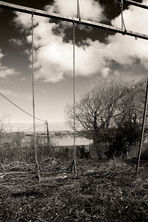Feels Like Home (2010)
Some years ago, a building in my locality, an old convent which had served for many years as an orphanage and latterly as a group home for teenagers, was vacated (the service moved to more ‘purpose suitable’ accommodation) and sold to a developer. I managed to persuade a member of the security firm monitoring the empty building to gain access, albeit only for 2 hours. My initial intention was to document the interior of the building – to secure a historical record of a building of local importance and significance in my community.
In the 2 days between organizing access and going to photograph the building, I ‘mulled’. I had worked with children in care, had known and talked to some people who had spent some of their childhood in this building and I began to imagine these people as those who would view the work, who it was for. I was aware through my work and from these conversations of certain ‘themes’ of ambiguity in the experience of childhood in such a context – ambiguity between abandonment and being cared for, ambiguity between ‘institution’ and sense of home, between the noise and ‘busy-ness’ of groups of children and the emptiness of a ‘left’ building.
With these themes swirling like mist in my thoughts, I wandered around the building– looking, noticing, feeling – stopping to photograph selections from what was around me. At the time this felt spontaneous and instinctive, but that is inaccurate – I wasn’t actually ‘chancing upon’ viewpoints that I was photographing, but was selecting moments that closely matched the themes that I was mulling on. Moments that spoke of the institutional or unhomelike qualities of the building, that carried the traces of the children who had once lived there, that reflected the use of the space as a ‘home’. Moments that presented abandonment and disrepair, echoing the abandonment and ‘brokenness’ of these childrens’ lives. (see also AV)



















